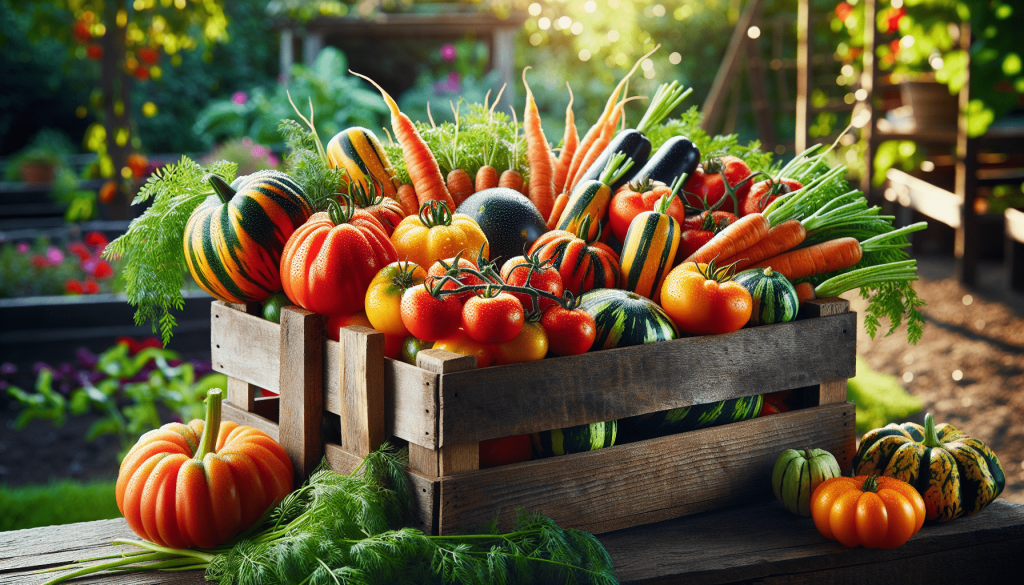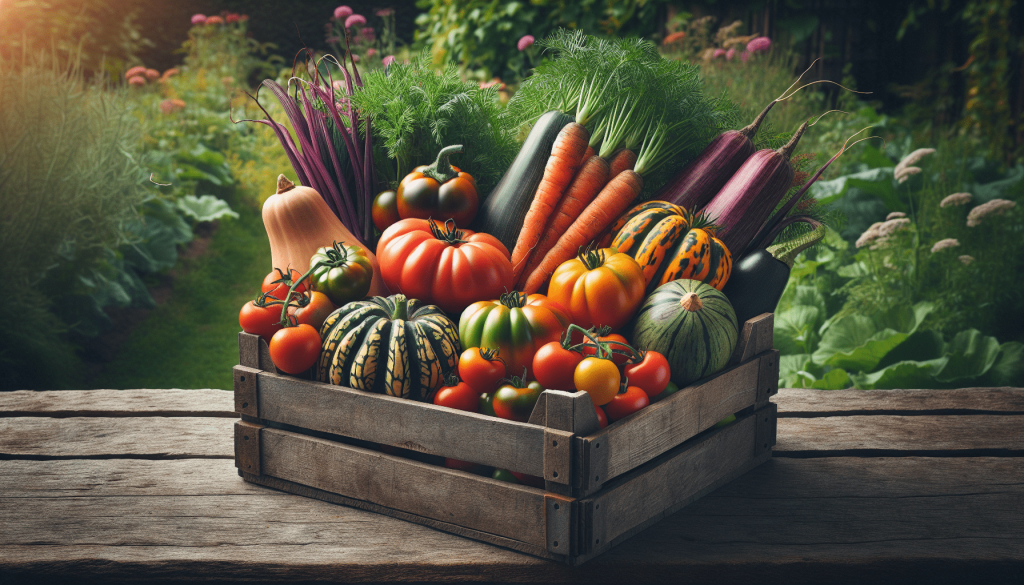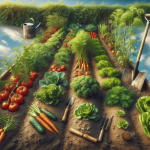This post may contain affiliate links. As an Amazon Associate, we may earn commissions from qualifying purchases.
What are the best practices for growing heirloom vegetables? If you’ve ever wondered how to get started with these timeless, flavorful varieties, you’re in the right place. Growing heirloom vegetables can be immensely rewarding, both in terms of taste and history. Let’s walk through the essential practices that will make your heirloom garden flourish.

Understanding Heirloom Vegetables
What Are Heirloom Vegetables?
Heirloom vegetables are open-pollinated varieties that have been passed down through generations. They are celebrated for their rich flavors, diverse colors, and historical significance. Unlike hybrids, heirloom varieties are not bred for shelf-life, and this often means a more robust and diverse flavor profile.
Why Grow Heirloom Vegetables?
Growing heirloom vegetables has several benefits. The flavor is often superior, and you’ll be preserving genetic diversity. Additionally, many heirloom varieties have fascinating stories behind them, adding a deeper connection to your garden.
Basics of Open-Pollination
Open-pollination is a key characteristic of heirloom vegetables. This means that these plants can produce seeds true to type, which you can save and replant. This is unlike hybrid varieties, which often do not produce reliable offspring.
Choosing the Right Heirloom Varieties
Assessing Your Growing Conditions
Before selecting heirloom varieties, it’s crucial to evaluate your garden’s conditions. Consider your climate, soil type, and available sunlight. Some heirloom varieties are more adaptable to specific conditions than others.
Researching Heirloom Varieties
Spend some time researching heirloom varieties that might be a good fit for your garden. Look into their growth habits, flavor profiles, and any particular care needs they might have. Seed catalogs, online forums, and local gardening groups can be fantastic resources.
Popular Heirloom Varieties
Here’s a table of some popular heirloom vegetables to consider:
| Vegetable | Variety | Growth Habit | Special Considerations |
|---|---|---|---|
| Tomato | Brandywine | Indeterminate | Requires staking, prone to cracking |
| Bell Pepper | California Wonder | Determinate | Resistant to several common pepper viruses |
| Carrot | Scarlet Nantes | Root | Prefers loose, sandy soils |
| Lettuce | Buttercrunch | Leafy | Best grown in cooler temperatures |
| Cucumber | Lemon Cucumber | Vining | Needs trellising for best results |
| Squash | Pattypan | Bush | Harvest frequently for best flavor |
Preparing Your Garden
Soil Preparation
Healthy soil is the foundation of a thriving vegetable garden. Aim for well-draining soil enriched with organic matter. Conduct a soil test to determine its pH and nutrient levels. Most heirloom vegetables prefer a slightly acidic to neutral pH (around 6.0 to 7.0).
Composting and Mulching
Incorporate compost into your garden beds to enrich the soil with necessary nutrients. Mulching with straw, wood chips, or grass clippings can help retain soil moisture, suppress weeds, and regulate soil temperature.
Planning Your Garden Layout
Consider companion planting and crop rotation when planning your layout. Grouping compatible plants together and rotating crops yearly can help manage pests and maintain soil fertility.
Planting Your Heirloom Seeds
Starting Seeds Indoors
Some heirloom vegetables benefit from an early start indoors, especially in regions with shorter growing seasons. Use seed-starting trays and a high-quality seed-starting mix. Ensure adequate light and moisture for germination.
Direct Sowing
For many heirloom vegetables, direct sowing into the garden is the best choice. Follow the seed packet instructions for spacing and planting depth. Water gently but thoroughly after planting.
Transplanting Seedlings
If you started your seeds indoors, it’s essential to harden off the seedlings before transplanting them into your garden. Gradually expose them to outdoor conditions over a week or two to prevent shock.
Care and Maintenance
Watering Techniques
Consistent watering is vital for heirloom vegetables. Aim to keep the soil consistently moist but not waterlogged. Using soaker hoses or drip irrigation can efficiently deliver water to your plants’ roots.
Fertilization
While heirloom vegetables don’t usually require excessive fertilization, they do benefit from a balanced organic fertilizer. Compost, well-rotted manure, or commercially available organic fertilizers can provide the nutrients your plants need.
Pest and Disease Management
Heirloom varieties can be more susceptible to certain pests and diseases. Regularly inspect your plants for signs of trouble, and use organic methods to manage pests, such as neem oil, insecticidal soap, or introducing beneficial insects.
Harvesting Heirloom Vegetables
Determining Ripeness
Knowing when to harvest is key to enjoying heirloom vegetables at their peak flavor. Each variety has its own indicators of ripeness. For tomatoes, look for full coloration and a slight give when gently squeezed. For root vegetables, the shoulders should be visible above the soil line.
Proper Harvesting Techniques
Use clean, sharp tools to harvest your vegetables, and handle them gently to avoid bruising. Harvest regularly to encourage continued production, especially for fruiting vegetables like tomatoes and cucumbers.

Saving Seeds for Future Planting
Selecting Seeds to Save
Choose healthy, vigorous plants with the best fruits for seed saving. For fruits like tomatoes, peppers, and cucumbers, allow the fruit to fully ripen on the plant before harvesting for seeds.
Seed Cleaning and Storage
Clean and dry your seeds thoroughly before storing them. Store seeds in a cool, dark, and dry place to ensure they remain viable for future planting. Label your seeds with the variety and date of harvest.
Understanding Seed Viability
Not all seeds retain their viability indefinitely. Generally, tomato seeds can last 4-6 years, while lettuce seeds may only last 1-2 years. Knowing the expected lifespan of your seeds can help you plan your garden better.
Troubleshooting Common Issues
Dealing with Poor Germination
Poor germination can be due to several factors, such as old seeds, incorrect planting depth, or inadequate water. Ensure you’re using fresh seeds, planting at the recommended depth, and keeping the soil consistently moist.
Managing Nutrient Deficiencies
Symptoms of nutrient deficiencies in heirloom vegetables can include yellowing leaves, stunted growth, or poor fruit development. A soil test can identify specific deficiencies, and appropriate fertilization can address them.
Preventing and Treating Diseases
Diseases such as blight, powdery mildew, and fusarium wilt can affect heirloom vegetables. Crop rotation, selecting disease-resistant varieties, and maintaining proper spacing for airflow can help prevent these diseases.
Expanding Your Heirloom Garden
Trying New Varieties
Once you have experience with a few heirloom varieties, consider expanding your garden with new and different ones. This can add variety to your harvest and introduce you to even more flavors and colors.
Sharing and Trading Seeds
Participating in seed swaps or sharing your saved seeds with other gardeners can help preserve heirloom varieties and build a sense of community. Plus, you may acquire new varieties to try in your own garden.
Joining Heirloom Gardening Communities
Gardening communities, both local and online, can be valuable resources. They provide support, share experiences, and offer advice specific to growing heirloom vegetables.
Understanding Heirloom Terminology
Indeterminate vs. Determinate
Tomatoes, for instance, can be indeterminate or determinate. Indeterminate varieties grow and produce fruit continuously until frost, while determinate varieties produce their yield all at once.
Open-Pollinated vs. Hybrid
Heirloom vegetables are always open-pollinated, meaning they breed true to type. Hybrids result from cross-pollinating different varieties to achieve specific traits but do not produce reliable offspring if replanted.
Heirloom vs. Heritage
While the terms are often used interchangeably, “heritage” can sometimes refer to livestock breeds that have been preserved over generations. In gardening, “heirloom” is the more commonly used term.
Importance of Biodiversity
Genetic Resilience
Heirloom vegetables contribute to biodiversity, offering a wider range of genetic material than modern hybrids. This genetic diversity can provide resilience against pests, diseases, and changing climate conditions.
Flavor and Nutrition
Heirloom varieties are often richer in flavor and nutrients compared to their commercial counterparts. By growing heirlooms, you’re not only preserving history but also enjoying superior taste and quality.
Environmental Impact
Growing heirloom vegetables can be more environmentally friendly. They often require fewer chemical inputs and can be more adapted to specific local conditions. This reduces the need for extensive pest control and fertilizers.
Engaging Your Senses
Visual Appeal
Heirloom vegetables often come in a variety of colors and shapes, making your garden visually stunning. Imagine purple carrots, yellow tomatoes, or striped beans gracing your garden beds.
Aromas and Flavors
The unique flavors and aromas of heirloom vegetables can transform your culinary experiences. Freshly harvested heirloom tomatoes or cucumbers can elevate a simple salad to a gourmet dish.
Culinary Adventures
Experimenting with heirloom vegetables can be a culinary adventure. Try heirloom recipes or create your own, and share your creations with friends and family.
Reflecting on Your Gardening Journey
Learning and Growing
Gardening is a continuous learning experience. Each season brings new challenges and successes. Reflect on what worked well and what could be improved for the next growing season.
Celebrating Harvests
Celebrate your harvests, no matter how big or small. The fruits of your labor are a testament to your dedication and care. Enjoy the flavors, share with loved ones, and take pride in your heirloom garden.
Planning for the Future
As you wrap up one growing season, start planning for the next. Consider what new heirloom varieties you’d like to try, what adjustments you might make to your garden layout, and what goals you have for the future.
Resources for Further Learning
Gardening books, online courses, and local gardening clubs can offer additional learning opportunities. Continually expanding your knowledge will make you a more successful heirloom gardener.
Conclusion
Growing heirloom vegetables can be a gratifying endeavor, bringing you closer to nature and history while providing nutritious, flavorful produce. By understanding the basics of heirlooms, properly preparing your garden, and following best practices for planting, care, and harvest, you can enjoy the many benefits these unique vegetables have to offer. So, roll up your sleeves, dig in, and anticipate a bountiful heirloom harvest!
If you have any questions or need more personalized advice, don’t hesitate to reach out to fellow gardeners or local gardening experts. Take pride in knowing that you’re preserving a piece of agricultural history and creating a more diverse, delicious future.








